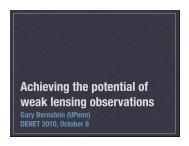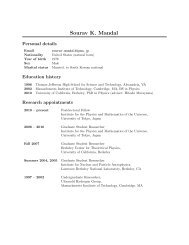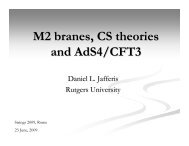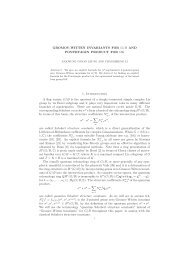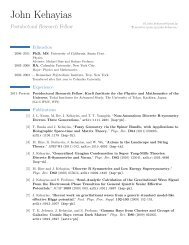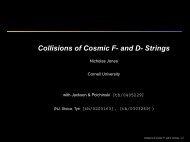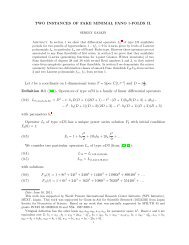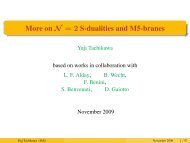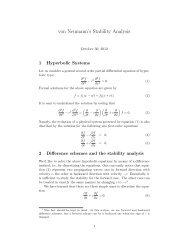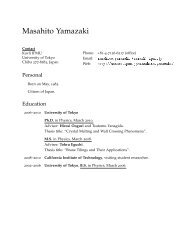STUDY SUMMARY - IPMU
STUDY SUMMARY - IPMU
STUDY SUMMARY - IPMU
Create successful ePaper yourself
Turn your PDF publications into a flip-book with our unique Google optimized e-Paper software.
<strong>SUMMARY</strong> REPORT<br />
WIDE FIELD FIBER-FED OPTICAL<br />
MULTI-OBJECT SPECTROMETER (WFMOS)<br />
5.0 Integration and Test<br />
5.1 Integration Approach<br />
Our history in delivering science instruments has enabled us to develop a systematic approach<br />
to I&T where it is common to have subsystems developed and tested by different groups.<br />
Emphasis on early validation at the subsystem level with clear definitions of interfaces allows<br />
verification of functionality and identification of problems early and minimizes the problems encountered<br />
when the instrument is finally assembled and tested as a system. Initial sub-system<br />
level validation also provides early test data to confirm interfaces, especially data content and<br />
form. The verification process of the instrument begins with the development of the Acceptance<br />
Test Plan (ATP) to define the series of tests, inspection, and analyses used to validate the instrument<br />
requirements. This plan will emphasize subsystem level tests and subassembly tests to verify<br />
functionality and performance early and to identify any problems and minimize telescope<br />
time for acceptance tests. At each stage we weigh the differences in response or performance<br />
when simulating an interface against the complexity of higher level tests, time and personnel<br />
necessary to debug higher level assembly tests, and finally telescope time at the full system level<br />
to determine when each requirement should be validated.<br />
The strategy in developing the ATP is:<br />
• Develop tests with clear objectives and success criteria.<br />
• Validate as many requirements as possible at the lowest level.<br />
• Select representative tests to confirm tests at the previous stage after the next integration<br />
step.<br />
• Select simple interfaces and identify risks associated with use of simulators and support<br />
equipment compared to a higher system-level test.<br />
• Minimize telescope time for Acceptance Tests by identifying the minimal set of tests that,<br />
in conjunction with previous tests and analysis, will fully validate the instrument.<br />
An example of how this process works for the PFI is described in Section 2.14.6 of the Detailed<br />
Design Document. A similar approach is developed for every assembly and subsystem.<br />
These tests are defined as the design progresses to ensure features needed for I&T are built into<br />
the software and hardware and the necessary laboratory facilities are available at the appropriate<br />
time.<br />
Examination of the instrument block diagram (Figure 3.2-1) shows this instrument can be integrated<br />
along two paths: one involving the telescope-mounted hardware and the other for the<br />
spectrograph, detectors and data pipeline. The software control system will be installed and<br />
tested at both integration sites. All of this occurs prior to integration onto the telescope, and the<br />
only test missed is the overall optical throughput, which can easily be calculated from individual<br />
tests. These parallel paths will also be followed in the initial telescope installation work before<br />
the final on-sky work commences. The advantages of this approach are minimizing the risk to<br />
schedule by allowing parallel independent progress and flexibility for as long as possible and<br />
maximizing the total resource available to the integration Phase by using two integration sites.<br />
The full plan is detailed below and shown schematically in Figure 5.1-1. The System Software<br />
will require careful management as modifications and bugs will be appearing simultaneously<br />
from two sites/time zones.<br />
63



